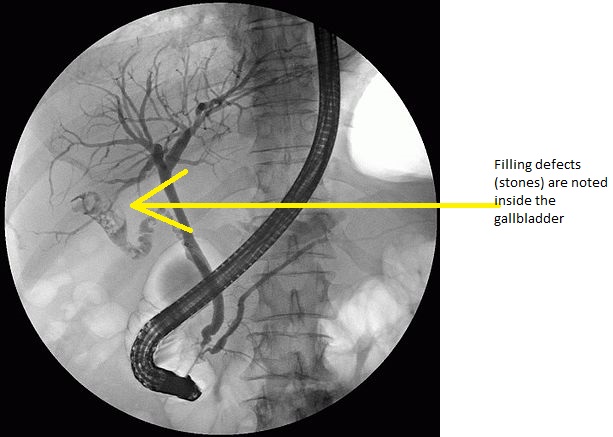Gallstone disease other imaging findings: Difference between revisions
Jump to navigation
Jump to search
m (Categories) |
|||
| (23 intermediate revisions by 6 users not shown) | |||
| Line 1: | Line 1: | ||
__NOTOC__ | __NOTOC__ | ||
{{Gallstone disease}} | {{Gallstone disease}} | ||
{{CMG}} | |||
{{CMG}}; {{AE}} {{HM}} | |||
==Overview== | ==Overview== | ||
== Other Imaging Findings == | There are other imaging modalities that can be useful in diagnosing [[gallstone disease]], these include; [[endoscopic retrograde cholangiopancreatography]] (ERCP), bile [[microscopy]] and oral cholecystography. It should be noted however, that some of these have been replaced by non-invasive, more advanced and less expensive imaging techniques. | ||
* | |||
==Other Imaging Findings== | |||
*Endoscopic retrograde cholangiopancreatography | ===Endoscopic retrograde cholangiopancreatography=== | ||
*[[Endoscopic retrograde cholangiopancreatography|Endoscopic retrograde cholangiopancreaticogram]] (ERCP) is an invasive procedure that requires technical expertise and often performed by inserting a tube into the [[common bile duct]] while the patient is [[Sedation|sedated]].<ref name="pmid8538344">{{cite journal |vauthors=Prat F, Amouyal G, Amouyal P, Pelletier G, Fritsch J, Choury AD, Buffet C, Etienne JP |title=Prospective controlled study of endoscopic ultrasonography and endoscopic retrograde cholangiography in patients with suspected common-bileduct lithiasis |journal=Lancet |volume=347 |issue=8994 |pages=75–9 |year=1996 |pmid=8538344 |doi= |url=}}</ref><ref name="pmid25719222">{{cite journal |vauthors=Gurusamy KS, Giljaca V, Takwoingi Y, Higgie D, Poropat G, Štimac D, Davidson BR |title=Endoscopic retrograde cholangiopancreatography versus intraoperative cholangiography for diagnosis of common bile duct stones |journal=Cochrane Database Syst Rev |volume= |issue=2 |pages=CD010339 |year=2015 |pmid=25719222 |doi=10.1002/14651858.CD010339.pub2 |url=}}</ref><ref name="pmid18226685">{{cite journal |vauthors=Tse F, Liu L, Barkun AN, Armstrong D, Moayyedi P |title=EUS: a meta-analysis of test performance in suspected choledocholithiasis |journal=Gastrointest. Endosc. |volume=67 |issue=2 |pages=235–44 |year=2008 |pmid=18226685 |doi=10.1016/j.gie.2007.09.047 |url=}}</ref> | |||
*[[Contrast medium|Contrast material]] is then injected to allow visualization of the [[biliary tree]]. | |||
*Traditionally, [[Endoscopic retrograde cholangiopancreatography|ERCP]] was not only [[Diagnosis|diagnostic]] but is also [[Therapy|therapeutic]], so that if a stone was detected, it could be removed in the same sitting. | |||
*The [[Sensitivity (tests)|sensitivity]] of [[Endoscopic retrograde cholangiopancreatography|ERCP]] for [[choledocholithiasis]] is estimated to be 80 - 93%. | |||
*[[ERCP]] has largely been replaced by [[Magnetic resonance cholangiopancreatography|MRCP]] and is now reserved for patients at a high risk of having a common bile duct stone, particularly with [[cholangitis]]. | |||
[[Image:fu.jpg|thumb|center|500px|Gallstones are seen as filling defects in the gallbladder. Source:wikiwand<ref name="urlwww.wikiwand.com">{{cite web |url=http://www.wikiwand.com/en/Common_bile_duct_stone |title=www.wikiwand.com |format= |work= |accessdate=}}</ref> ]] | |||
===Oral cholecystography=== | |||
*Oral cholecystography is rarely done since being replaced by the transabdominal [[ultrasound]].<ref name="pmid7979854">{{cite journal |vauthors=Shea JA, Berlin JA, Escarce JJ, Clarke JR, Kinosian BP, Cabana MD, Tsai WW, Horangic N, Malet PF, Schwartz JS |title=Revised estimates of diagnostic test sensitivity and specificity in suspected biliary tract disease |journal=Arch. Intern. Med. |volume=154 |issue=22 |pages=2573–81 |year=1994 |pmid=7979854 |doi= |url=}}</ref> | |||
*It is still occasionally used prognostically to evaluate [[Gallbladder|gall bladder]] function in obese patients on medical dissolution therapy such as [[Ursodiol|ursodeoxycholic acid]] where a high quality ultrasound cannot be obtained. | |||
==References== | ==References== | ||
{{Reflist|2}} | {{Reflist|2}} | ||
{{WH}} | |||
{{WS}} | |||
[[Category:Gastroenterology]] | [[Category:Gastroenterology]] | ||
[[Category:Hepatology]] | [[Category:Hepatology]] | ||
[[Category:Surgery]] | [[Category:Surgery]] | ||
[[Category: | [[Category:Disease]] | ||
[[Category: | [[Category:Radiology]] | ||
Latest revision as of 21:59, 22 December 2020
|
Gallstone disease Microchapters |
|
Diagnosis |
|---|
|
Treatment |
|
Surgery |
|
Case Studies |
|
Gallstone disease other imaging findings On the Web |
|
American Roentgen Ray Society Images of Gallstone disease other imaging findings |
|
Risk calculators and risk factors for Gallstone disease other imaging findings |
Editor-In-Chief: C. Michael Gibson, M.S., M.D. [1]; Associate Editor(s)-in-Chief: Hadeel Maksoud M.D.[2]
Overview
There are other imaging modalities that can be useful in diagnosing gallstone disease, these include; endoscopic retrograde cholangiopancreatography (ERCP), bile microscopy and oral cholecystography. It should be noted however, that some of these have been replaced by non-invasive, more advanced and less expensive imaging techniques.
Other Imaging Findings
Endoscopic retrograde cholangiopancreatography
- Endoscopic retrograde cholangiopancreaticogram (ERCP) is an invasive procedure that requires technical expertise and often performed by inserting a tube into the common bile duct while the patient is sedated.[1][2][3]
- Contrast material is then injected to allow visualization of the biliary tree.
- Traditionally, ERCP was not only diagnostic but is also therapeutic, so that if a stone was detected, it could be removed in the same sitting.
- The sensitivity of ERCP for choledocholithiasis is estimated to be 80 - 93%.
- ERCP has largely been replaced by MRCP and is now reserved for patients at a high risk of having a common bile duct stone, particularly with cholangitis.

Oral cholecystography
- Oral cholecystography is rarely done since being replaced by the transabdominal ultrasound.[5]
- It is still occasionally used prognostically to evaluate gall bladder function in obese patients on medical dissolution therapy such as ursodeoxycholic acid where a high quality ultrasound cannot be obtained.
References
- ↑ Prat F, Amouyal G, Amouyal P, Pelletier G, Fritsch J, Choury AD, Buffet C, Etienne JP (1996). "Prospective controlled study of endoscopic ultrasonography and endoscopic retrograde cholangiography in patients with suspected common-bileduct lithiasis". Lancet. 347 (8994): 75–9. PMID 8538344.
- ↑ Gurusamy KS, Giljaca V, Takwoingi Y, Higgie D, Poropat G, Štimac D, Davidson BR (2015). "Endoscopic retrograde cholangiopancreatography versus intraoperative cholangiography for diagnosis of common bile duct stones". Cochrane Database Syst Rev (2): CD010339. doi:10.1002/14651858.CD010339.pub2. PMID 25719222.
- ↑ Tse F, Liu L, Barkun AN, Armstrong D, Moayyedi P (2008). "EUS: a meta-analysis of test performance in suspected choledocholithiasis". Gastrointest. Endosc. 67 (2): 235–44. doi:10.1016/j.gie.2007.09.047. PMID 18226685.
- ↑ "www.wikiwand.com".
- ↑ Shea JA, Berlin JA, Escarce JJ, Clarke JR, Kinosian BP, Cabana MD, Tsai WW, Horangic N, Malet PF, Schwartz JS (1994). "Revised estimates of diagnostic test sensitivity and specificity in suspected biliary tract disease". Arch. Intern. Med. 154 (22): 2573–81. PMID 7979854.